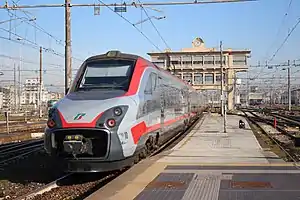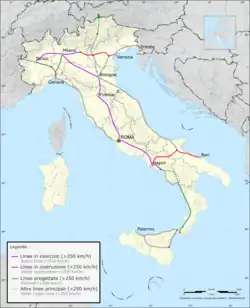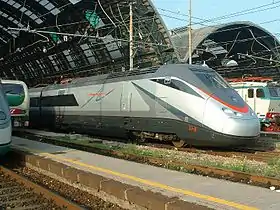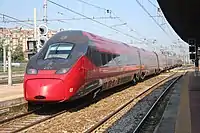



High-speed rail in Italy consists of two lines connecting most of the country's major cities. The first line connects Turin to Salerno via Milan, Bologna, Florence, Rome and Naples, the second runs from Turin to Venice via Milan and Verona, and is under construction in parts.[1] Trains are operated with a top speed of 300 km/h (190 mph).
Passenger service is provided by Trenitalia and, since April 2012, by NTV, the world's first private open-access operator of high-speed rail to compete with a state-owned monopoly. 25 million passengers traveled on the network in 2011.[2] In 2015, ridership increased to 55 million for Trenitalia[3] and 9.1 million for NTV,[4] for a combined 64 million passengers.
History
The first high-speed rail route in Italy, the Direttissima, opened in 1977, connecting Rome with Florence. The top speed on the line was 250 km/h (160 mph), giving an end-to-end journey time of about 90 minutes with an average speed of 200 km/h (120 mph). This line used a 3 kV DC supply.
High-speed service was introduced on the Rome-Milan line in 1988–89 with the ETR 450 Pendolino train, with a top speed of 250 km/h (160 mph) and cutting travel times from about 5 hours to 4.[6] The prototype train ETR X 500 was the first Italian train to reach 300 km/h (190 mph) on the Direttissima on 25 May 1989.[6]
The Italian high-speed rail projects suffered from a number of cost overruns and delays. Corruption and unethical behaviour played a key role.[7]
In November 2018, the first high-speed freight rail in the world commenced service in Italy. The ETR 500 Mercitalia Fast train carries freight between Caserta and Bologna in 3 hours and 30 minutes, at an average speed of 180 km/h (110 mph).[8][9]
Rolling stock
Service on the high speed lines is provided by Trenitalia and the privately owned NTV. Several types of high-speed trains carry out the service:
- AGV 575: non-tilting, it can reach 360 km/h (220 mph) and has an operational speed of up to 300 km/h (190 mph), operated by NTV as Italo;
- ETR 500: non-tilting, it can reach 360km/h, operational speeds up to 300 km/h (190 mph), operated by Trenitalia as the Frecciarossa;
- ETR 1000: non-tilting, operated by Trenitalia as the Frecciarossa 1000, it can reach 400 km/h (250 mph) and has operational speed of 300 km/h (190 mph).[10]
- ETR 485, tilting, speeds up to 250 km/h (160 mph), operated by Trenitalia as the Frecciargento. It operates mainly on traditional lines;
- ETR 600, tilting, speeds up to 250 km/h (160 mph), operated by Trenitalia as the Frecciarossa. It operates on routes that include relatively important sections on traditional lines, but also high-speed ones;
- ETR 610: tilting, speeds up to 250 km/h (160 mph), operated by Trenitalia on EuroCity trains between Italy and Switzerland together with Giruno trainsets;
- ETR 675: non-tilting, operated by NTV as Italo;
- ETR 700: non-tilting, speeds up to 250 km/h (160 mph), operated by Trenitalia as Frecciarossa mostly on routes consisting of sections on both traditional and high-speed lines.
Current limitations on the tracks set the maximum operating speed of the trains at 300 km/h (186 mph) after plans for 360 km/h (224 mph) operations were cancelled.[11] Development of the ETR 1000 by AnsaldoBreda and Bombardier Transportation (which is designed to operate commercially at 360 km/h (224 mph), with a technical top speed of over 400 km/h (249 mph), is proceeding, with Rete Ferroviaria Italiana working on the necessary updates to allow trains to speed up to 360 km/h (224 mph). On 28 May 2018, the Ministry for Infrastructures and Transportation and the National Association for Railway Safety decided not to run the 385 km/h (239 mph) tests required to allow commercial operation at 350 km/h (217 mph), thus limiting the maximum commercial speed on the existing Italian high-speed lines to 300 km/h (186 mph) and cancelling the project.[12][13]
TGV trains also run on the Paris-Turin-Milan service, but do not use any high-speed line in Italy.[14]
Network

The following high-speed rail lines are in use.
| Line | Length km | Opening | Travel time | Top speed km/h | Voltage |
|---|---|---|---|---|---|
| Florence–Rome "Direttissima" | 254 | 24 February 1977 / 26 May 1992 | 1:18 | 250[15] | 3 kV DC |
| Rome–Naples | 205 | 19 December 2005 / 13 December 2009 | 1:08 | 300[15] | 25 kV 50 Hz |
| Turin–Milan | 125 | 10 February 2006 (Turin-Novara) 13 December 2009 (Novara-Milan) | 0:44 | 300[15] | 25 kV 50 Hz |
| Padua–Venice (Mestre) | 25 | 1 March 2007 | 0:14 | 220[15] | 3 kV DC |
| Milan–Verona (partly under construction) | 67[1] | 10 June 2007 (Milano-Treviglio) 11 December 2016 (Treviglio-Brescia) | 0:36 | 200 (Milano-Treviglio) [15] 300 (Treviglio-Brescia) |
3 kV DC
25 kV 50 Hz |
| Naples-Salerno "via Linea Monte Vesuvio" (L.M.V.) | 29 | 15 April 2008 | 0:30 | 250[15] | 3 kV DC |
| Milan–Bologna | 215 | 13 December 2008[16] | 0:53 | 300[15] | 25 kV 50 Hz |
| Bologna–Florence | 79 | 5 December 2009 | 0:35 | 300[15] | 25 kV 50 Hz |
| Total | 974 | ||||
The table shows minimum and maximum (depending on stops) travel times.[17]
| Bologna | Florence | Milan | Naples | Rome | Turin | |
|---|---|---|---|---|---|---|
| Bologna | - | 0:35 | 0:53 | 3:15 (3:35) | 1:54 (2:03) | 2:02 |
| Florence | 0:35 | - | 1:31 | 2:31 (2:51) | 1:18 (1:45) | 2:38 |
| Milan | 0:53 | 1:31 | - | 3:50 (4:18) | 2:40 (3:08) | 0:44 (1:00) |
| Naples | 3:15 (3:35) | 2:31 (2:51) | 3:50 (4:18) | - | 1:08 | 5:00 (5:25) |
| Rome | 1:54 (2:35) | 1:18 (1:45) | 2:40 (3:08) | 1:08 | - | 3:48 |
| Turin | 2:02 | 2:38 | 0:44 (1:00) | 5:00 (5:25) | 3:48 | - |
Milan to Salerno Corridor
The Milan to Salerno is the major north–south corridor of the high-speed network.
The Milan–Bologna segment opened on 13 December 2008. Its construction cost was about 6.9 billion euro. The 182 km (113 mi) line runs parallel to the Autostrada del Sole, crossing seven provinces and 32 municipalities. There are eight connections with historic lines. At the Reggio Emilia interconnection a new station designed by the Valencian architect Santiago Calatrava was opened in June 2013. Calatrava has also designed a signature bridge where the line crosses the A1 motorway. The line travels through a new multi-level station at Bologna (Italy's principal railway junction) designed by Japanese architect Arata Isozaki.

The Bologna–Florence segment opened on 12 December 2009, allowing a 37-minute journey between the two cities. The Bologna-Florence high-speed section was particularly complex to build mainly because about 93% of its 78.5 km (48.8 mi) runs through tunnels under the Apennines mountain range. The line has nine tunnels, from 600 meters to 18.5 km (11.5 mi) long, separated by short surface stretches (less than 5 km (3.1 mi) in total). Florence will have a major new multi-level high speed station at Belfiore designed by British architect Norman Foster.
The Florence–Rome segment consists of the older "Direttissima" (literally: most direct) line between the two cities, with a length of 240 km (150 mi). The first high-speed line in Europe, the "Direttissima" was completed in between 1977 and 1992. This segment is being upgraded by Rete Ferroviaria Italiana. Entering Rome, high-speed trains have the option of stopping at either the new intermodal station at Tiburtina, developed by architects ABD Associate led by Paolo Desideri, or Termini station.
The Rome-Naples segment heads south from the Italian capital. Service on the first new high speed segment of the project started in December 2005. This line runs through 61 municipalities in two regions (Lazio and Campania) and connects with the existing national rail network at Frosinone Nord, Cassino Sud and Caserta Nord. On 13 December 2009, work was completed on the last 18 km (11 mi) of the line between Gricignano and Napoli Centrale. In the Campania region, the line passes through Afragola where a major new transfer station has been built, designed by Iraqi-born architect Zaha Hadid.
Turin to Trieste Corridor
The Turin to Novara segment of the Turin to Trieste corridor runs for 85 km (53 mi) and opened in February 2006. The Novara to Milan segment opened on 12 December 2009, allowing a 59-minute journey between Milan Centrale and Turin Porta Nuova (45 minutes from Milan Porta Garibaldi to Turin Porta Susa). Combined, the two segments are 125 km (78 mi) long, 80% (98 km (61 mi)) of which are in the region of Piemonte (provinces of Turin, Vercelli and Novara) and 20% (27 km (17 mi) in the region of Lombardy (province of Milan). To minimize its environmental impact on the area, almost the entire length of the Turin to Milan high-speed line was constructed parallel to the A4 Turin-Milan motorway.
The Milan to Venice segment includes stretches from Padova to Mestre (for Venice), in service since March 2007,[19] and Milan to Brescia, which runs alongside the A35 motorway and opened for service on 11 December 2016.[20] Between Brescia and Verona the new high-speed line will parallel the A4 motorway for 30 of its 48 km (30 mi), and a 7.4-km tunnel will be constructed at Lonato del Garda.[21] This section is due for completion in 2023.[22] The final 75 km (47 mi) stretch between Verona and Padua will be constructed by quadrupling the existing railway. The contract for this was let in August 2020 with completion scheduled for 2027.[23] The section between Verona and Vicenza is to be constructed first.[24]
Ports and Trans-European Connections
A new line connecting Milan to the port of Genoa is now in development and further expansion of the trans-Alpine lines will integrate the Italian network with the European networks planned by the EU and the large intermodal Pan-European transport corridors.
The objective of the new Alpine rail links is to increase rail transport, aimed mainly at supporting the forecast development of freight transport on international lines, complete interoperability between European high-speed rail networks, the shift from road to rail of a large percentage of freight for modal rebalancing, higher safety levels in tunnels as specified in the new European technology and construction standards.
Planned engineering works include the construction of new international lines and the upgrading of existing Italian track on the following lines:
- Frejus (see Turin-Lyon high-speed railway)
- Gotthard (Chiasso-Monza and Gallarate-Bellinzona)
- Simplon (Domodossola-Novara railway)
- Brenner (Fortezza-Innsbruck)
- Tarvisio - Semmering (Udine-Tarvisio)
- Eastern Pass Valico Orientale (Venice-Trieste-Ronchi dei Legionari)
Lines under construction
Milan–Genoa
A line from Milan to Genoa was approved in 2006 at €6.2 billion; construction work started in 2011.[25] Work between Genoa and Tortona was temporarily halted due to funding problems, but restarted in 2019 and now is expected to be completed by 2026.[26]
Milan–Venice
On the line from Milan to Venice high speed trains still have to use the conventional line between Brescia and Padua. The remaining portion from Brescia to Padua is under construction at a cost of €2.5 billion, while the rest of the line is already in operation. The section between Brescia and Verona will be completed in 2023 while construction should finish on the section between Verona and Padua in 2027, including a 7.7 kilometer tunnel between Lonato del Garda and Desenzano del Garda.[27]
Naples–Bari
The construction of the line from Naples to Bari began in 2015[28] and will cut Naples–Bari journeys from four to two hours.[29] Totaling €6.2 billion for the whole project, the final €2.1 billion needed to complete the project was approved in 2019.[27] The completion of the line is projected for 2027.[29]
Palermo–Catania
Palermo and Catania, Sicily's largest cities, are currently connected by a double-track railway which is limited to a single-track section between Catenanuova and Bicocca (near Catania). This requires trains to stop and wait for the train from the opposite direction to pass. The first step to improving this line is doubling this single-track section of 38 kilometers. This will enable a higher maximum speed of 200 km/h (124 mph) compared to the current 90 km/h (56 mph).[30] Construction started in 2019 at a cost of €415 million. The work on both tracks is expected to finish in 2023. Eventually, further improvements as part of the entire €8 billion project will enable a maximum speed of 250 km/h (155 mph) on the line.[31] The upgrade of the line will reduce the journey time between Palermo and Catania to one hour and 45 minutes in 2025, saving one hour.[32]
Turin–Lyon
The Turin–Lyon line should connect Turin, Lyon and Chambéry, and join the Italian and the French high speed rail networks. It would take over the role of the current Fréjus railway. The project costs €26 billion, with the Mont d'Ambin Base Tunnel, a 57.5 kilometer trans-alpine tunnel between Italy and France, costing €18.3 billion.[33] Although the plan was highly controversial, the Italian senate approved funding in mid-2019,[34] with the project tentatively due to be completed in 2032.[35][36]
Verona–Innsbruck
The Brenner Base Tunnel will link Verona, Innsbruck, and Munich, and thus connect the Italian, Austrian and German railways. The tunnel is the most important link in a series of projects that will create a single connection from Berlin in Germany to Palermo in Sicily as part of the Trans-European Transport Networks. The tunnel crosses the border between Innsbruck in Austria and Franzensfeste in Italy. The total costs of the tunnel are estimated at €8.4 billion, of which 40% is co-financed in equal measure by Italy and Austria and 50% by the European Union.[37] As of 2020, half of the tunnel's length has been excavated[38] and it is due to be opened in 2032.[39]
A new high speed line between Verona and Fortezza is constructed on the Italian side and is about 180 kilometers long. The line will have a design speed of 200–250 kilometers and will quadruple the current two tracks of the existing low speed line. It has been budgeted at approximately €5 billion and is expected to be completed by the end of the works on the Brenner Base Tunnel.[37]
Lines planned
Salerno–Reggio Calabria
A line from Salerno to Reggio Calabria is currently in the planning stage. It is expected to be operational by 2030.[40] The new line will be 445 kilometers long and cost €22.8 billion. It will reduce the travel time from Rome to Reggio Calabria to three hours and forty minutes. This compares to five hours of current travel time for the existing railway between Salerno and Reggio Calabria, excluding the section between Rome and Salerno.[41]
The project is divided into seven functional lots:[41]
- Salerno-Battipaglia
- Battipaglia-Praia a Mare
- Praja a Mare-Tarsia
- Tarsia-Montalto Uffugo
- Montalto Uffugo-Lamezia Terme
- Lamezia Terme-Gioia Tauro
- Gioia Tauro-Reggio Calabria
See also
Further reading
- Binari dal Tevere all'Arno. La nuova linea direttissima Roma-Firenze, Roma, Ufficio relazioni aziendali delle Ferrovie dello Stato, 1974
- La Direttissima Roma-Firenze, in Ingegneria ferroviaria, gennaio 1978
- Azienda autonoma Ferrovie dello Stato, Direttissima Roma-Firenze, Roma, Ufficio relazioni aziendali delle Ferrovie dello Stato, 1978
- La Direttissima Roma-Firenze, in Ingegneria ferroviaria, marzo 1991
- Giampaolo Mancini, Donato Carillo, Mauro Papi, Prove a 320 km/h dell'ETR 500 Politensione, in Ingegneria ferroviaria, 56 (2001), n. 8, pp. 513–519
- Bruno Cirillo, Paolo Comastri, Pier Luigi Guida, Antonio Ventimiglia, L'Alta Velocità ferroviaria, Roma, Collegio Ingegneri Ferroviari Italiani, 2009, ISBN 978-88-95634-05-0,
External links
- rfi.it - Rete Ferroviaria Italiana (RFI), infrastructure manager
- Railway Technology.com article on Italian High Speed Rail, including NTV
- trenitalia.com - Trenitalia official website and online booking
- italotreno.it - Nuovo Trasporto Viaggiatori (NTV) Italo online booking
References
- 1 2 "Brescia high speed line construction begins". Railway Gazette. 11 May 2012. Retrieved 14 July 2012.
- ↑ "Alta velocità e concorrenza: parte la sfida". il Sole 24 Ore. Retrieved 28 April 2012.
- ↑ "Alta velocità, in dieci anni 300 milioni di passeggeri". Il Sole 24 ORE (in Italian). Retrieved 4 July 2017.
- ↑ "Articolo su Italiaoggi.it".
- ↑ "Il mercato del Trasporto Ferroviario A/V - NTV, Nuovo Trasporto Viaggiatori". www.ntvspa.it. Retrieved 23 March 2023.
- 1 2 "Alta velocità. Una storia di successi tutti italiani" (PDF). Trenitalia. Retrieved 16 December 2011.
- ↑ Locatelli, Giorgio; Mariani, Giacomo; Sainati, Tristano; Greco, Marco (2017-04-01). "Corruption in public projects and megaprojects: There is an elephant in the room!". International Journal of Project Management. 35 (3): 252–268. doi:10.1016/j.ijproman.2016.09.010.
- ↑ van Leijen, M. (11 February 2018). "High Speed freight train Italy hits the track on 7 November". ProMedia Group. Retrieved 24 April 2019.
- ↑ van Leijen, M. (22 March 2019). "High-speed line for freight: not just fast, also on time". ProMedia Group. Retrieved 24 April 2019.
- ↑ Marco Morino: All'Expo con il Frecciarossa 1000 Il Sole 24 Ore, 7 August 2014
- ↑ "Italy rejects plans to increase speed to 350km/h". International Railway Journal. 2018-05-31. Retrieved 2019-03-15.
- ↑ "RFI fined for discrimination in planning for 360km/h operation". International Railway Journal. 2018-08-08. Retrieved 2019-03-15.
- ↑ Lucio Cillis: Repubblica Affari e Finanza, 2018-05-28
- ↑ Substantial travel time differences between the French TGV (around 80 minutes) and Italian high speed trains (around 50 minutes) (Both non-stop times). This time difference of 30 minutes can only be caused by the TGV taking the slower classic route. The fast regional trains who do not take the high speed take only slightly a bit longer, but they have more stops. There is one TGV that stops in Novara with only marginal extra time. It is not possible to stop in Novara without using the Novara - Milan old classic line. Consulted 2017 and 2016 timetables.
- 1 2 3 4 5 6 7 8 see Fascicoli Circolazione Linee links in for technical data of RFI (Rete Ferroviaria Italiana) lines
- ↑ Reuters Italy launches Milan-Bologna high speed train link December 13, 2008
- ↑ The table is based on Trenitalia timetables (2011)
- ↑ "Due record in prova per il Frecciarossa" (in Italian). Repubblica. 2009-02-04. Retrieved 2009-02-05.
- ↑ "Verona-Padua-Venice High Speed/High Capacity Line". Italferr. Retrieved 2020-10-04.
- ↑ "High speed network grows as Brescia–Treviglio route opens". Railway Gazette. 2016-12-12. Retrieved 2020-10-04.
- ↑ "Italy builds high-speed railway between Brescia and Verona". Railway Pro. 2017-07-19. Retrieved 2020-10-04.
- ↑ "Works continue for Brescia Est–Verona high speed rail". Railway Pro. 2020-04-20. Retrieved 2020-10-04.
- ↑ "Work Starts on First Section of Verona Padua High-Speed Railway". Metro Rail News. 2020-08-13. Retrieved 2020-10-04.
- ↑ "Verona–Vicenza high speed line contract awarded". Railway Gazette. 2020-08-14. Retrieved 2020-10-04.
- ↑ "Terzo Valico - Milano-Venezia e Terzo Valico - RFI". Archived from the original on 2015-04-02. Retrieved 2015-03-28.
- ↑ "Terzo Valico - Nodo di Genova".
- 1 2 2019-07-25T16:11:33+01:00. "New lines go ahead as FS infrastructure spending approved". Railway Gazette International. Retrieved 2020-03-05.
{{cite web}}: CS1 maint: numeric names: authors list (link) - ↑ Briginshaw, David (29 September 2016). "FS to invest €94bn and double turnover by 2026".
- 1 2 Burroughs, David (3 April 2021). "WEBUILD installs first of three 2500-tonne bridges for Naples – Bari high-speed line". International Railway Journal. Retrieved 8 July 2021.
- ↑ "Europe's subway arrives in Sicilia". We Build Value Digital Magazine. 13 January 2021. Retrieved 13 July 2021.
- ↑ "Work commences to double the Bicocca-Catenanuova railway along the Palermo-Catania line". Ferrovie dello Stato Italiane. 25 March 2019. Retrieved 13 July 2021.
- ↑ "Ferrovie: via a lavori sulla Catania-Palermo, treni a 200 all'ora". ilSicilia.it. 25 March 2019. Retrieved 13 July 2021.
- ↑ Bellamy, Daniel (2019-07-27). "Italy agrees to resume controversial Turin-Lyon high-speed rail link". euronews. Retrieved 2020-03-05.
- ↑ "Italian Senate backs train link with France, widening coalition rift". euronews. 2019-08-07. Retrieved 2020-03-05.
- ↑ "SAINT-JEAN-DE-MAURIENNE. Les travaux du Lyon-Turin débutent le 15 janvier". www.ledauphine.com (in French). Retrieved 2020-03-05.
- ↑ Le Dauphiné Libéré (2021-07-07). "France / Italie. Lyon-Turin : les marchés du tunnel de base attribués". Ledauphine.com. Retrieved 2022-04-11.
- 1 2 "The Brenner Pass and the Fortezza Verona Line". Ferrovie dello Stato Italiane. Retrieved 9 July 2021.
- ↑ "Brenner Base Tunnel Excavation Reaches Halfway Point". Tunnel Business Magazine. 2020-02-05. Retrieved 2020-03-05.
- ↑ "Governors protest latest delay to Brenner Base Tunnel construction". 27 May 2021.
- ↑ "Tav, Salerno-Reggio Calabria pronta entro il 2030". Affaritaliani (in Italian). 27 April 2021. Retrieved 29 December 2021.
- 1 2 Messina, Piero (16 October 2021). "Alta velocità Salerno – Reggio Calabria, il progetto costerà 22,8 miliardi". Resto al Sud (in Italian). Retrieved 29 December 2021.
.jpg.webp)
